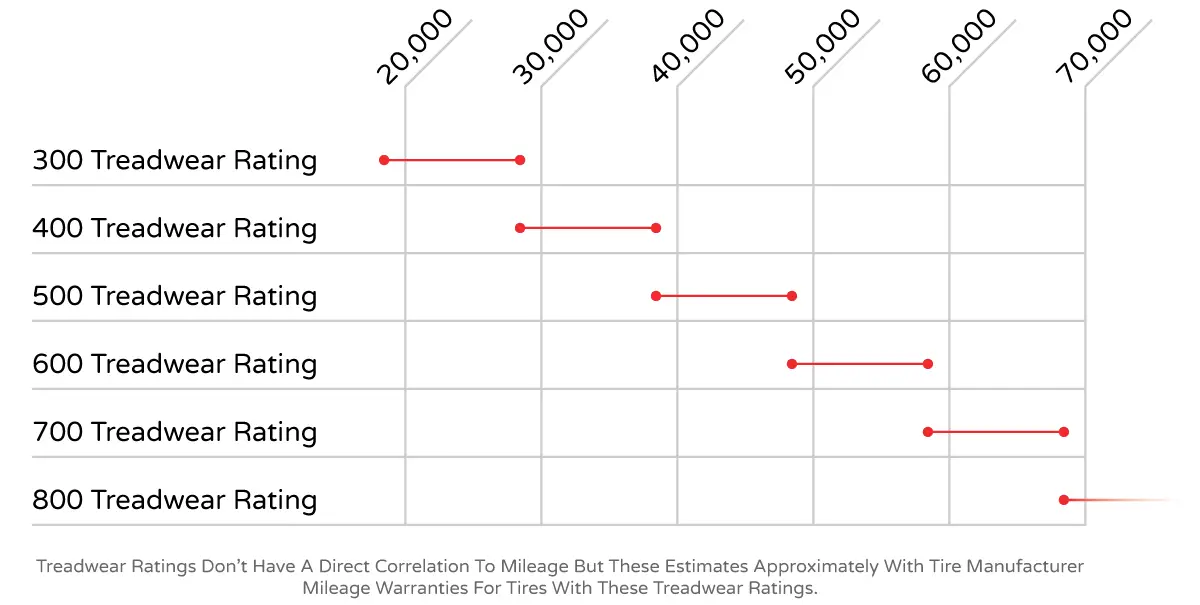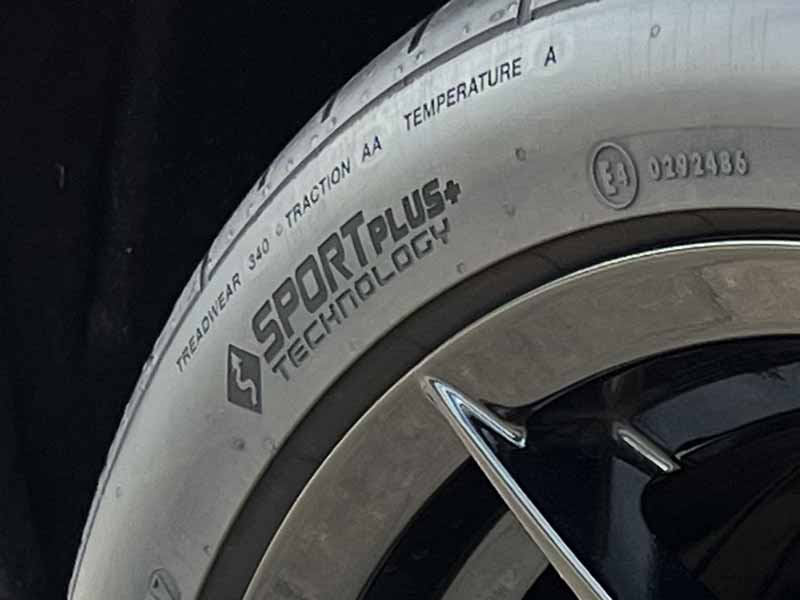It’s difficult to know what the real difference is between two tires. Tire manufacturers spend a lot on advertising to explain how much better there tire is than the competition’s tire. That usually just confuses the matter.
UTQG is a rating system that’s designed to help consumers cut through the marketing hype and get a better understanding of the real differences between two seemingly identical tires.
What Is UTQG
UTQG is the abbreviation for the Uniform Tire Quality Grading system created by the National Highway Traffic Safety Administration (NHTSA). It measures treadwear, traction, and temperature resistance of a tire in a controlled environment.
The UTQG rating can be found on the sidewall of most passenger vehicle tires. This test system is designed to give consumers an “apples-to-apples” measurement to compare tires when shopping.
UTQG isn’t perfect. It’s a system that has been in place for a long time and needs to be updated to account for the advances in tire technology. Despite that, it is still quite helpful.
Let’s take a closer look
What Are The Three UTQG Ratings?
The 3 UTQG ratings are:
- Treadwear
- Traction
- Temperature
The uniform tire quality grade for each of these metrics comes from the results of a specified government test to ensure an “apples-to-apples” comparison between all tires (with some exceptions) sold in the United States.
UTQG Exceptions
Most passenger car tires are rated with the Uniform Tire Quality Grading system, but some are exempt for various reasons. The following are tires that are exempt:
- Winter Tires
- Spare Tires
- Non-Passenger Car Tires
- Trailer Tires
- Some Large Truck Tires
What Is A Good UTQG Rating
An excellent UTQG rating would be 800 AA A and is possible to achieve. Generally speaking, anything equal to or greater than a UTQG 500 A B is a good rating. Ratings below this may be worthwhile in some circumstances, but for average passenger vehicles, this is a good minimum.
Performance vehicles demand tires with better traction grades but this tends to cause lower treadwear grades. In this case, treadwear grades below 500 are more common with traction grades of AA.
Traction grades of B or C and temperature grades of C should generally be avoided except in more unique circumstances where these performance metrics may not be as critical for your needs.
Is Higher UTQG Better
Higher ratings are always better when it comes to tire ratings. But the truth is that this system is outdated though and these tire grades are helpful, but not the only metric you should consider when making a tire purchase.
I encourage you to read our article on How To Buy Tires for a more well-rounded understanding of what to look for when shopping for tires.
UTQG Treadwear Rating
Treadwear grades are designed to give shoppers of passenger vehicle tires a consistent metric to compare a tire’s ability to resist wear.
The reference tire design achieves a treadwear grade of 100. Since this test is quite old now, most modern tires exceed this rating by orders of magnitude.
A treadwear grade is not a guarantee of mileage achievable. It is only a measurement of a tire’s performance under specified test conditions when compared to the baseline test tire.
Many factors affect how long a tire will last, such as driving habits and type of car or truck the tires are mounted on.
UTQG Treadwear Chart

Tire Treadwear Meaning
Tire treadwear refers to how quickly or slowly a tire will wear down when used. A treadwear grade of 100 is equal to the reference tire used by the DOT when test testing tire treadwear. Higher numbers are better.
What Is A Good Treadwear Rating
The treadwear grade ranges from 100 to 800 with 500 and above generally being a good treadwear rating. Some tires with lower ratings are quite good but will generally wear more quickly.
Wear rates are not the only metric to consider. Performance tires will usually have lower expected tire life overall due to the need for softer rubber compounds. However it will usually have excellent traction coefficients and temperature resistance.
UTQG Traction Rating
The traction rating of a tire is a very limited test of a tire’s ability to grip the road surface. It only measures braking on wet pavement and has nothing to do with a tire’s ability to resist hydroplaning or its dry traction performance.
The traction grade is not a measure of braking distance but a measure of how much G-force is produced when braking on wet pavement.
The tests are performed in under controlled conditions and on specified government test surfaces.
Braking distance is affected by many factors, most importantly the weight of the car or truck. G-force is a more consistent comparative rating.
Tire Traction Grade Meaning
Tire traction grade refers to a measurement of a tires stopping ability on a wet road surface. There are only 4 possible grades which are listed below from highest to lowest:
- AA
- A
- B
- C
Tire Traction Rating Chart
Wet Road Surface Braking Performance On Specified Government Test Surfaces (G-Force)
| Traction Grade | Wet Asphalt | Wet Concrete |
|---|---|---|
| AA | More Than 0.54 G | More Than 0.38 G |
| A | More Than 0.47 G | More Than 0.35 G |
| B | More Than 0.38 G | More Than 0.26 G |
| C | Less Than 0.38 G | Less Than 0.26 G |
Tire Traction Rating AA
A traction grade of AA is the best possible rating. Tires with that meet this standard have exceptional wet weather grip and are usually performance oriented tires.
Tires with a traction grade of AA are able to create more than 0.54 of G-force under hard braking on wet asphalt and greater than 0.38 of G-force when braking on wet concrete.
Tire Traction Rating AA Vs A
A traction grade of A is slightly lower than AA but still good tire. Unfortunately, the standard needs to be updated since the majority of tires fall into this category and this metric doesn’t tell us much about wet weather performance.
Tires with a traction grade of A are able to create more than 0.47 of G-force under hard braking on wet asphalt and greater than 0.35 of G-force when braking on wet concrete.
Tire Traction Rating A Vs B
A traction grade of B is slightly lower than A but this doesn’t mean it is acceptable. Due to the overwhelming majority of tires being classified with an A rating, tires that only achieve a B rating are not terribly good compared to the average.
Tires with a traction grade of B are able to create more than 0.38 of G-force under hard braking on wet asphalt and greater than 0.26 of G-force when braking on wet concrete.
Tire Traction Rating B Vs C
A traction grade of C is quite poor. Modern tires rarely fail to meet at least a rating of B. If a tire can only manage a traction rating of C I would highly recommend searching for a better performing tire.
Tires with a traction grade of C are only able to create less than 0.38 of G-force under hard braking on wet asphalt and less than 0.26 of G-force when braking on wet concrete.
UTQG Temperature Rating
Temperature grades are a measure of a tire’s resistance to heat generated when traveling at high speeds. The stresses a passenger tire must endure at high speeds are extreme and heat resistance is a critical measure of how safe a tire is at these higher speeds.
Temperature grades are limited to three ratings from best to worst:
- A
- B
- C
What Does Temperature Rating Mean On Tires?
The ratings that tires are given for temperature resistance are related to the speed they can be safely used.
Tire Temperature Rating Chart
A measure of a tire’s resistance to heat at a continuous speed (MPH)
| Temperature Grades | Safe Sustainable Speed |
|---|---|
| A | Above 115 mph |
| B | Between 115 mph and 100 mph |
| C | Between 100 mph and 85 mph |
Tire Temperature Rating A
A temperature grade of A is the highest possible rating and means that the tire has been tested to withstand speeds in excess of 115 miles per hour.
The majority of modern tires meet this standard.
Tire Temperature Rating A Vs B
A temperature grade of B is not as good as A but still capable of safely maintaining speeds between 100 and 115 miles per hour which is well above most legal speed limits in the United States.
Although most tires manufactured today meet the A rating, there are still many tires on the market that fall into the B temperature rating. This are perfectly adequate and you should have no concerns if they meet your requirements.
Tire Temperature Rating B Vs C
A temperature grade of C is obviously not as good as a B rating but is still safe for use at highway speeds. It is capable of safely resisting heat generated at speeds between 85 and 100 miles per hour.
Only a very small percentage of modern tires fail to meet the A or B standard and fall into the C category. While tires in this classification are acceptable to use, I would look for other options if your budget allows.
Resources
Below are some links you may find helpful when learning about tires
Final Thoughts
Tire manufacturers go to great lengths to make amazing tires that not only have excellent road characteristics and perform well for the Department Of Transportation’s UTQG rating system, but also perform well in the real world and actual conditions.
This government standard battery of tests is showing its age as tire manufacturers have improved tire performance over the years. Some of the ratings are less helpful now than they once were.
Despite this, UTQG is extremely helpful when comparing tires side-by-side for a good apples-to-apples metric that can help you get a better understanding of some of the actual differences between the tires.
We hope this article has been helpful and armed you with the information you need to make an informed tire purchase. Be sure to also read our article on How To Buy Tires for a more comprehensive guide.
Good luck and happy motoring.






